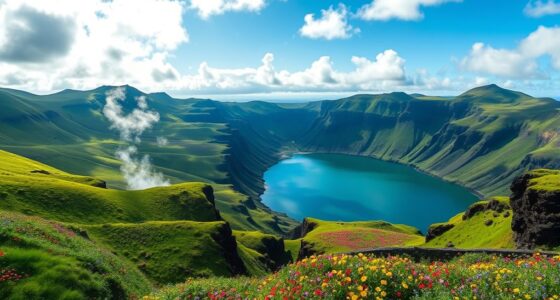Explore lesser-known towns like Kovachevitsa and Zheravna, where traditional architecture and customs thrive away from crowds. Discover scenic mountain trails, crystal-clear lakes, and thrilling river adventures. Immerse yourself in authentic cultural festivals, vibrant local art scenes, and regional cuisines rich in flavor. While accessibility can be tricky, sustainable travel options are growing. Keep going to uncover even more hidden treasures of Eastern Europe and experience its true, untouched beauty.
Key Takeaways
- Discover lesser-known historic villages like Kovachevitsa and Zheravna, preserving authentic architecture and traditional customs away from crowds.
- Explore natural landscapes with scenic mountain trails, tranquil lakes, and rivers offering outdoor adventures like hiking, kayaking, and rafting.
- Experience regional festivals, craft workshops, and vibrant art scenes in lesser-visited towns such as Plovdiv’s Kapana District and Sibiu.
- Visit UNESCO wooden churches and ancient monasteries that showcase unique regional craftsmanship and spiritual heritage.
- Enjoy regional culinary delights, traditional crafts, and cultural activities rooted in local history and rural traditions.
Discovering Lesser-Known Historic Towns and Villages

Many of Eastern Europe’s most enchanting historic towns and villages remain hidden treasures, offering authentic glimpses into the region’s rich cultural past. You can explore Kovachevitsa and Dolen in Bulgaria’s Rhodope mountains, where traditional customs thrive amidst 18th- and 19th-century stone-and-timber architecture. Zheravna, in the Balkan foothills, features well-preserved buildings showcasing centuries-old craftsmanship. Koprivishtitsa in the Sredna Gora Mountains offers undulating scenery and historic houses that reflect timeless rural life. These villages preserve a sense of authenticity, with elders in traditional attire and agricultural practices still visible daily. Their untouched historic architecture and customs create a vivid picture of the region’s cultural heritage, inviting you to experience a slower, more genuine way of life far from modern crowds.
Exploring Natural Landscapes and Outdoor Adventures

You can hike along spectacular mountain trails that wind through rugged peaks and lush forests, offering breathtaking views at every turn. If you prefer water, try kayaking on serene lakes or rafting down rushing rivers for an adrenaline rush. No matter your choice, exploring these natural landscapes promises unforgettable outdoor adventures. Additionally, observing wave and wind patterns can enhance your experience by helping you choose the best times for water activities.
Mountain Hiking Trails
Eastern Europe’s mountain hiking trails offer a diverse range of natural landscapes and outdoor adventures, from gentle slopes in the Carpathians to rugged peaks in the Balkans and the Alps. You’ll encounter trails with varying trail difficulty, from accessible routes through lower elevations to challenging paths requiring certified guides. Mountain infrastructure ranges from basic village-based paths in the Carpathians to well-marked, tourist-friendly trails in the High Tatras with mountain huts. Imagine:
- Wide, gentle slopes with wildflower meadows
- Rugged, rocky ascents with panoramic views
- Glacier crossings needing specialized equipment
- Well-maintained mountain huts along the trails
- Less developed, remote routes with fewer hikers
Whether you’re seeking a casual hike or a demanding trek, Eastern Europe’s trails offer a perfect mix of natural beauty and adventure. Additionally, understanding industry trends can help you select the most rewarding routes and gear for your outdoor pursuits.
Serene Lake Activities
Have you ever wondered how peaceful a quiet lake can be amidst stunning natural surroundings? These lakes offer the perfect setting for serene activities like lake kayaking and wildlife watching. At Veliko and Malo Jezero in Mljet National Park, you can paddle through calm waters surrounded by Mediterranean vegetation, enjoying the tranquility away from crowds. Lake Sevan in Armenia provides expansive, cool waters ideal for scenic kayaking, with mountain views enhancing your experience. The Plitvice Lakes in Croatia feature crystalline turquoise waters, where canoeing reveals cascading waterfalls and lush flora. Nearby lakes in Eastern Europe, often nestled within forests and wetlands, attract migratory birds and wildlife, making early mornings and evenings ideal for wildlife watching. Lakes in Eastern Europe are often part of protected areas and serve as important habitats for diverse species. These peaceful spots invite you to connect deeply with untouched nature, offering opportunities for biodiversity conservation and ecological appreciation.
River Rafting Experiences
Starting on a river rafting adventure allows you to immerse yourself in some of Europe’s most stunning natural landscapes while enjoying an exhilarating outdoor activity. You’ll encounter crystal-clear waters, plunging waterfalls, and calm pools that follow each rapid, creating a perfect balance of thrill and scenery. The Tara River, with its whitewater challenges on the 11-mile stretch from Brstanovica to Šćepan Polje, offers adrenaline-pumping Class III-IV rapids through Europe’s last wild river and the world’s second deepest canyon. Along the way, you’ll see rugged cliffs, lush forests, and pristine ecosystems. Multi-day trips blend adventure with cultural immersion, letting you experience local traditions after conquering the river’s whitewater challenges. It’s an unforgettable way to explore nature’s raw beauty. River rafting in Eastern Europe offers a unique opportunity to combine excitement with scenic exploration, making it a must-try for outdoor enthusiasts. Moreover, projector technology continues to advance, providing clearer visuals and enhanced immersion for viewers.
Immersing in Cultural and Artistic Hotspots Off the Beaten Path

You can experience vibrant local art festivals that reveal unique traditions and contemporary creativity beyond the usual tourist spots. Visiting historic cultural sites offers a glimpse into the rich heritage that shapes each region’s identity. Engaging with local artists and their work provides authentic, memorable connections to these hidden gems. High Tatras National Park is home to rare species like Eurasian lynx, Tatra marmots, and golden eagles, emphasizing the region’s natural cultural significance. Exploring traditional crafts and local artisans can further deepen your understanding of the area’s cultural landscape.
Local Art Festivals
Exploring local art festivals in Eastern Europe offers a unique way to immerse yourself in the region’s rich cultural tapestry beyond popular tourist spots. These festivals blend contemporary art with cultural preservation, showcasing rural traditions alongside innovative expressions. You might find yourself:
- Walking through vibrant art installations in a small Serbian village
- Listening to indie and experimental music in a forest near Budapest
- Watching international films and avant-garde theatre in Transylvania
- Participating in workshops that celebrate local crafts and stories
- Engaging with community-led performances that honor regional heritage
Each event emphasizes sustainability and community involvement, fostering authentic connections. These festivals highlight the region’s creative diversity, offering a fresh perspective on Eastern Europe’s artistic landscape beyond mainstream hubs. It’s your chance to witness the vibrant pulse of local culture and contemporary art, often set in natural or historic sites that amplify the sensory experience which reflect social and historical contexts. Additionally, many of these festivals incorporate elements of local art festivals that celebrate regional traditions and contemporary innovation.
Historic Cultural Sites
Beyond vibrant art festivals, Eastern Europe’s lesser-known historic sites offer a compelling glimpse into the region’s rich cultural tapestry. The UNESCO Wooden Churches of Maramureș in Romania showcase 17th- and 18th-century wooden architecture, with intricate carvings and paintings that reflect centuries of cultural preservation. These active worship centers embody traditional Romanian faith practices and rural lifestyles, offering immersive insights into a living cultural heritage. In Ukraine, the Pyrohiv Open-Air Museum reconstructs traditional village life through over 300 wooden structures, preserving folk architecture and craft traditions. Armenia’s ancient monasteries and ruins, some from early medieval times, highlight the region’s earliest Christian sites, maintaining their authenticity through limited tourism. These sites preserve historical architecture and cultural practices, making them essential for understanding Eastern Europe’s authentic history beyond the mainstream. Additionally, wooden architecture in these sites demonstrates the region’s mastery of natural materials and craftsmanship passed down through generations.
Unique Artistic Experiences
Hidden artistic treasures await in lesser-known Eastern European cities and neighborhoods, where vibrant local scenes flourish away from crowded tourist spots. Here, you can plunge into street art murals that transform urban landscapes, explore contemporary galleries showcasing innovative works, and experience underground art hubs that foster local talent. These spaces often serve as a creative incubator for emerging artists, enriching the local culture with fresh perspectives.
- Colorful houses and lively murals in Plovdiv’s Kapana District
- Modern art exhibitions in Sofia’s Red Flat
- Roman mosaics and ancient performance venues in Split
- Wine-themed art exhibits in Tokaj’s cozy galleries
- Historic art collections at Sibiu’s Brukenthal Museum
These vibrant spaces blend history with modern creativity, offering immersive artistic experiences beyond typical tourist routes. You get to witness how local artists reinterpret tradition through street art and contemporary galleries, making each visit uniquely inspiring.
Unique Local Experiences and Unconventional Activities

Eastern Europe offers a wealth of authentic experiences that go beyond typical sightseeing, inviting you to engage deeply with local culture and traditions. You can explore hidden artisans mastering centuries-old crafts like pottery, weaving, and woodcarving in Carpathian villages, helping preserve folklore traditions. Attend immersive festivals such as Poland’s Wianki or Hungary’s Busó Fest, where music, dancing, and masquerades celebrate ancient customs. Participating in seasonal rituals like harvest celebrations or Easter egg-decorating reveals unique local practices rooted in agricultural cycles. Markets filled with traditional handmade goods give you insight into regional craftsmanship and support local artisans. These unconventional activities let you connect with the true spirit of Eastern Europe, far from crowded tourist spots, creating memorable, culturally rich experiences. Cultural preservation plays a vital role in maintaining these unique local traditions and crafts for future generations.
Tasting Regional Culinary Delights and Local Specialties

Exploring local crafts and traditions often leads to discovering the region’s most delicious flavors. You’ll encounter traditional dishes crafted from regional ingredients, each telling a story of history and culture. Savor pierogi filled with mashed potatoes, cheese, or fruits, often served with sour cream or onions. Indulge in hearty goulash, a smoky Hungarian beef stew flavored with paprika and garlic. Enjoy borscht, a vibrant beetroot soup served hot or cold, accompanied by sour cream and rye bread. Relish stuffed cabbage rolls simmered in tomato gravy, a family favorite across Eastern Europe. And don’t miss kielbasa with crispy potato pancakes, a satisfying combination of meats and potatoes. These regional ingredients and cooking techniques create flavors that are both comforting and unique. Recognizing soulmate angel numbers can also reveal your readiness to embrace love and deepen connections in your life.
Navigating Tourism Trends and Overcoming Accessibility Challenges

Recent shifts in tourism trends are boosting the appeal of lesser-known destinations across the region, making it easier for you to discover new cultural and natural sites. Enhanced digital accessibility and transportation infrastructure are key drivers, lowering entry barriers and improving connectivity. Direct flights and upgraded rail and road networks facilitate seamless travel, especially to rural and remote areas. Regional airports now serve smaller destinations, attracting more visitors. Government partnerships with airlines increase route options and seasonal services, easing access. However, challenges remain, like limited public transport in peripheral areas and seasonal disruptions affecting reliability. Infrastructure gaps, especially for accessible travel, still need addressing. Sustainable transport options, such as bike paths and eco-shuttles, are emerging to support mobility without harming natural sites. Improving transportation infrastructure can further boost regional tourism and accessibility.
Sustainable Tourism: Preserving Heritage and Natural Beauty

As tourism in Eastern Europe grows, balancing visitor numbers with the preservation of heritage and natural landscapes becomes increasingly important. You can contribute by choosing eco conscious accommodations and supporting responsible travel initiatives that prioritize sustainability. Imagine wandering through ancient towns, surrounded by well-preserved castles and lush forests, without damaging these treasures. Visualize local communities thriving through sustainable tourism, where cultural traditions are celebrated and protected. Envision digital tools helping manage visitor flows, preventing overcrowding and environmental damage. Picture vibrant markets offering authentic crafts, with responsible travelers engaging respectfully with locals. Incorporating mindfulness practices can also enhance visitors’ appreciation of these cultural and natural sites, fostering a deeper respect and commitment to preservation.
Support sustainable tourism in Eastern Europe by choosing eco-friendly stays and respecting local heritage and natural landscapes.
- Strolling through historic streets free of pollution
- Staying in eco-friendly lodges nestled in nature
- Participating in community-led cultural tours
- Visiting protected natural reserves with minimal impact
- Supporting initiatives that ensure ongoing heritage preservation
Frequently Asked Questions
What Are the Best Times of Year to Visit These Hidden Eastern European Destinations?
The best seasons to visit these hidden Eastern European destinations are spring and autumn, offering mild weather and fewer crowds. You’ll enjoy comfortable temperatures for sightseeing and outdoor activities, plus vibrant seasonal scenery. Weather considerations favor shoulder seasons for better rates and authentic local experiences. Avoid peak summer for crowds or winter if you want holiday markets and thermal baths. These times give you the perfect blend of pleasant weather and cultural richness.
How Can Travelers Access Remote Villages With Limited Transportation Options?
You can overcome transportation challenges and improve rural connectivity by using demand-responsive transport services like on-demand shuttles or dial-a-ride programs. Renting a car offers flexibility when public transit is limited, but be prepared with printed maps and local advice. Combining regional trains or buses with digital apps for real-time info can also help, ensuring you reach remote villages efficiently despite sparse transportation options.
Are There Guided Tours Available for Exploring Lesser-Known Natural Landscapes?
Imagine wandering through lush forests, mountain peaks scraping the sky, and quiet valleys untouched by crowds. Guided tour options make natural landscape exploration easy, taking you off the beaten path to discover Eastern Europe’s hidden treasures. With local guides leading you through remote villages, gorges, and alpine scenery, you’ll safely experience the region’s untouched beauty and rich culture, all while soaking in breathtaking views you won’t find in typical tourist spots.
What Local Customs Should Visitors Respect When Engaging in Authentic Experiences?
When engaging in authentic experiences, you should respect local etiquette and dress codes. Greet locals with simple phrases, observe social behaviors, and avoid assuming your customs apply. Dress modestly at religious sites and follow local standards, especially in rural areas. Show appreciation by finishing your food, be punctual, and avoid loud behavior. Asking locals for guidance on customs demonstrates respect, making your interactions more genuine and enriching your travel experience.
How Do Small Towns Balance Tourism Growth With Heritage Preservation Efforts?
Think of small towns as delicate tapestries, where every thread represents heritage and growth. You can help balance tourism by embracing sustainable tourism practices and active heritage management. Support local initiatives, respect preservation laws, and participate in eco-friendly activities. By doing so, you guarantee these towns retain their authentic charm while welcoming visitors responsibly—preserving their stories for generations to come. Your mindful choices help keep the harmony between growth and heritage intact.
Conclusion
By venturing beyond the usual tourist spots, you’ll uncover the true soul of Eastern Europe’s hidden gems. These lesser-known towns, landscapes, and cultural hotspots offer authentic experiences that can’t be found in guidebooks. Embrace the adventure and remember, it’s often the journey off the beaten path that reveals the most unforgettable treasures. So, don’t be afraid to step outside your comfort zone—you’ll find that the road less traveled truly makes all the difference.









